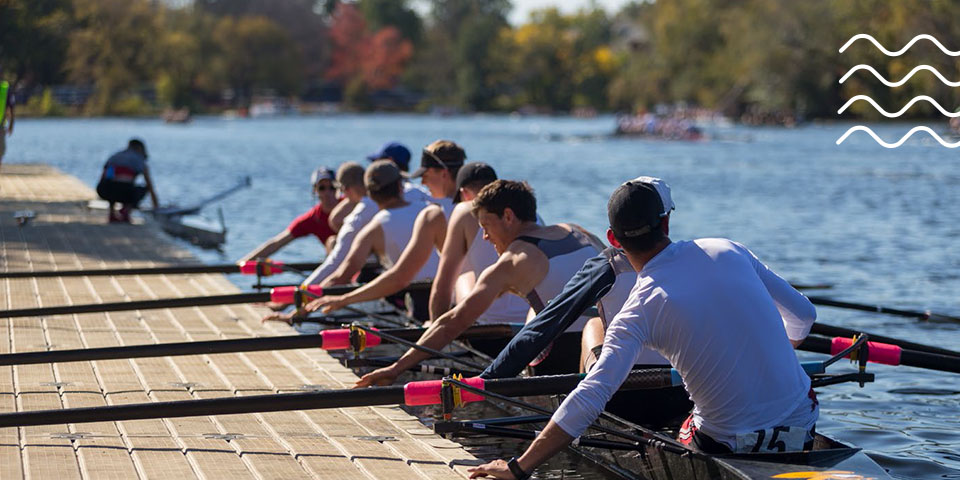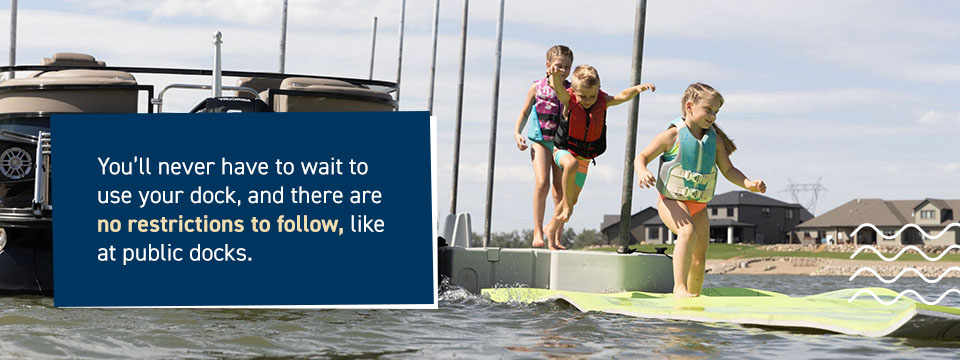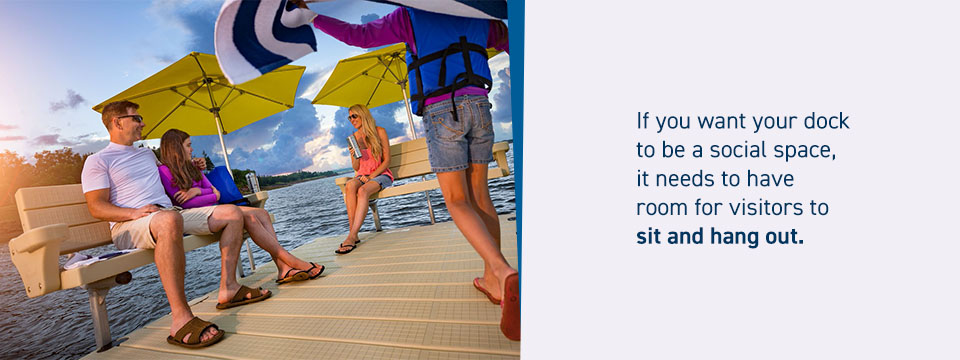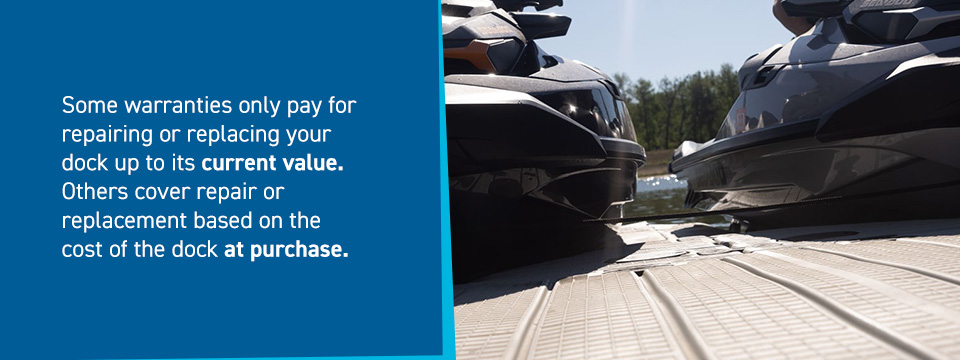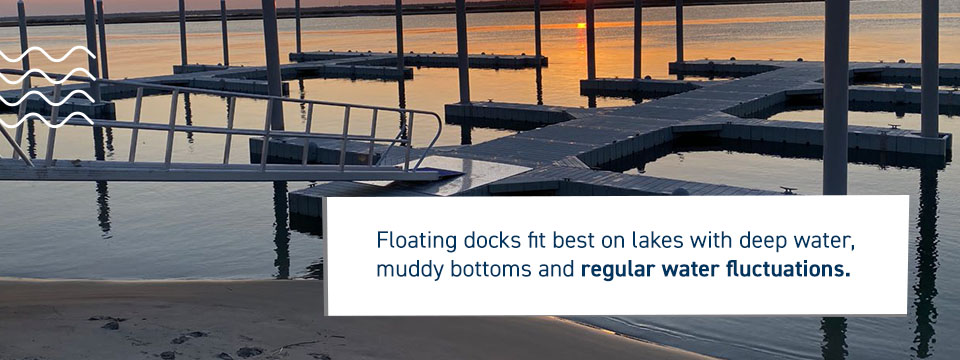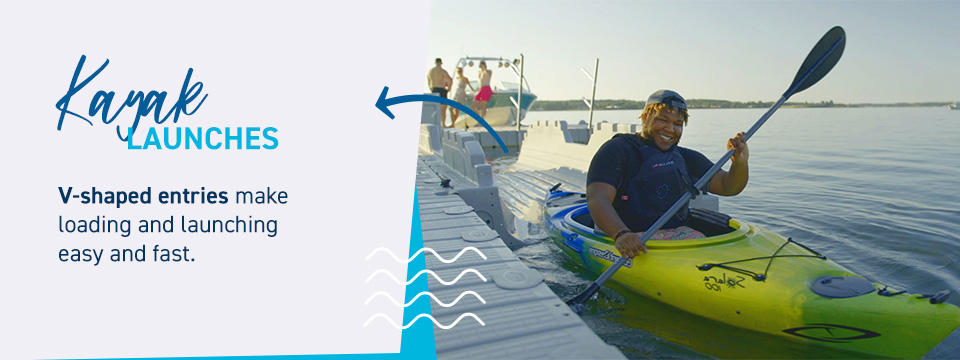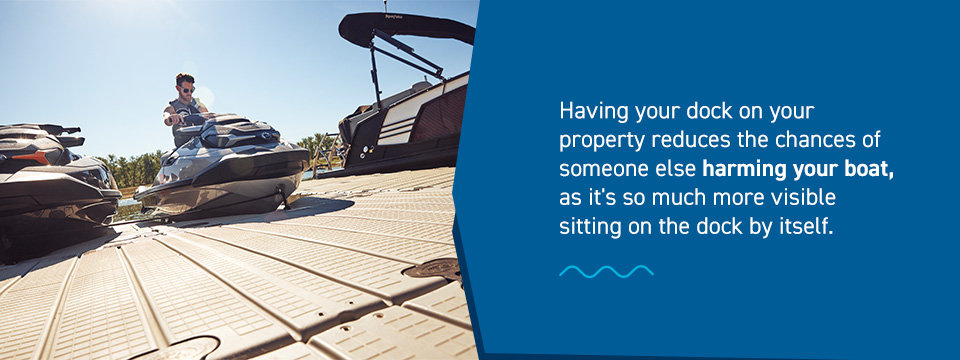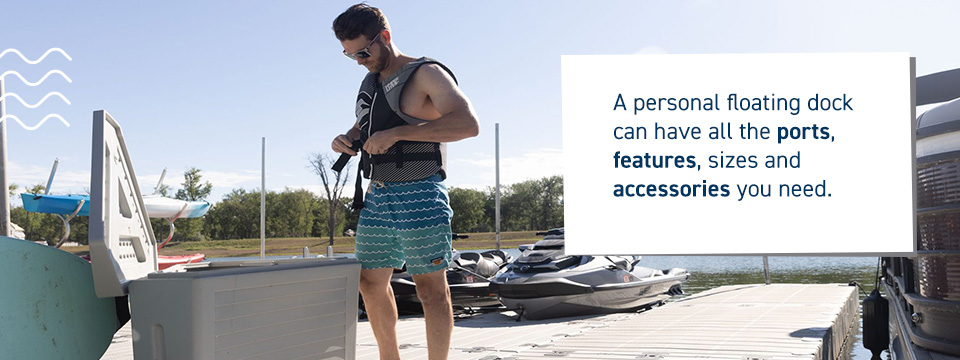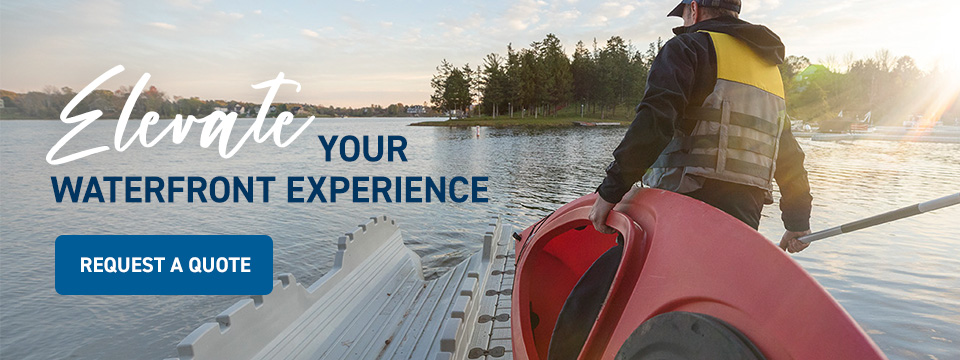Filters
Things to Consider When Choosing a Lake Dock
Owning a lakefront property means you can enjoy all the benefits of the water without dealing with the stress of public lake access. Many lakefront homeowners invest in boats and watercraft to maximize their lakeside access. Installing a private lake dock maximizes your water access and allows you to use your watercraft with little stress or effort.
If you already have a boat or watercraft you use at a public dock, getting a private lake dock cuts out the intermediary entirely. You control the dock’s look, configuration, maintenance and storage. With a lake dock, you can use your watercraft on the lake whenever you want — just step outside your door and onto your dock.
Lake docks are a significant investment — you need them to last, securely hold your watercraft and make watercraft use easy. Choosing a lake dock depends on many factors, and getting the right one will significantly improve your lake enjoyment. Understanding what to look for in a lake dock allows you to make the best purchase and get the most out of your investment.
Why Purchase a Lake Dock?
Purchasing a lake dock can dramatically improve your watercraft experience. With added convenience, safety and custom features, you can have better access to the water than ever before.
Many boat and watercraft owners invest in a lake dock to get more time on the water and control over their boat use. Lake docks allow friends and family to enjoy the waterfront safely — there’s no worrying about damaging crafts at the public port or getting in the way of someone else’s loading and unloading process.
Lake docks give you more control over your lake experience. You never have to wait to use the dock, and there are no restrictions to follow, like at public docks. You can customize your dock to fit your needs exactly. If you’re looking for more convenient, personal boat use, a lake dock is perfect.
Getting a dock means considering all lake and craft use factors. Purchasing a lake dock has many benefits, but you should take the time to ensure you get the right one. A well-fitting lake dock will make your lake use much more accessible and bring you years of relaxation and fun.
7 Steps to Choosing the Right Lake Dock
There are several lake dock factors to consider when upgrading your waterfront experience. Following the proper steps will help you narrow down your options — the more research you do, the better prepared you’ll be. Evaluating these features will help you find the best dock for you:
1. Determine Your Usage
Your dock must securely hold all your personal watercraft (PWC) and meet your usage needs. The more boats you have, the more ports you’ll need your dock to accommodate. Additionally, your dock needs to be longer than your boat to make docking as easy as possible. You should consider all the uses you’ll need your dock for — fishing, entertaining, relaxing and docking are typical boat uses.
Some docks are used exclusively for docking boats, while others are more leisure-focused. If you want your dock to be a social space, it needs to have room for visitors to sit and hang out. Consider rails and lights if you’re getting your dock as a walkway.
The dock’s closeness to the surface, the functions you want your dock for and other use options all affect the kind of dock you’ll need. Knowing precisely what you want your dock for will help you pick the best one.
2. Think About Size and Weight Capacity
Local governments usually have dock regulations to help protect people, shorelines and wildlife. These regulations limit floating dock weight and length to help protect the area. You might need a permit to build your dock or make it meet specific conditions before installing it.
Check with your local government to ensure your preferred dock model and size is within regulation. You’ll save yourself the headache of a non-compliant dock and get approval for your dock ahead of time. After investing time and energy into researching and selecting a dock, the last thing you want is to find yourself with a dock you can’t set up on your lake shore.
3. Evaluate Types of Materials
Dock material and model depend heavily on your dock’s location. The lake bed, water depth, and regular weather conditions all affect the dock you end up with. Gangways made from polyethylene and aluminum have their own benefits — the right gangway depends on your location’s conditions. EZ Dock floating docks are made from durable, low-maintenance polyethylene for maximum strength and sleekness.
Polyethylene is an ideal dock material for most lakes. While natural materials like wood are prone to rot, splintering and paint chips, polyethylene has none of these drawbacks. It’s low-maintenance, so you need to do little to keep it clean and safe. It’s even strong enough to withstand tropical storm winds. Capable of holding up to saltwater and freshwater conditions, polyethylene is often the best material choice for your dock.
Additionally, EZ Dock floating docks aren’t filled with foam. Foam is often used in floating docks to help with floatation, but foam can pollute the environment if exposed. When the dock exterior is compromised, foam can break off into the lake or be eaten by wildlife. Choosing a foamless floating dock helps prevent pollution and wildlife harm.
4. Consider Cost and Maintenance
Your dock’s material, location and use all affect its cost and maintenance. Decide how much time and money you’re willing to invest in your dock. Polyethylene is low-maintenance and durable in the cold. However, depending on the season and area, some dock styles need to be brought in. Finding a dock that meets your budget and maintenance needs will help keep your dock use affordable and fun rather than stressful and time-consuming.
Budget is often a critical factor for many dock buyers. While you want to avoid spending too much on your dock, not investing enough into it will lead to a lower-quality dock that needs more frequent repairs and replacement. Evaluate your budget carefully — investing in a quality dock will save you lots of money and time over the years.
The larger and more custom your dock, the more it’ll cost. If you need something custom to fit lots of watercraft or suit leisure use, you’ll need to spend more. Further, choosing a low-maintenance material can save you time and money in the long run, but some dock owners enjoy regular dock maintenance. Something like wood will require lots of care and frequent repairs. Synthetic materials like polyethylene last much longer in the water and require far less maintenance than wood.
5. Look for a Warranty
Most floating docks come with warranties to cover potential issues that pop up with your dock. However, some warranties are more comprehensive than others. You should read the fine print carefully for each dock warranty — ensure it covers everything you want. Some warranties only pay for repairing or replacing your dock up to its current value. Others cover repair or replacement based on the cost of the dock at purchase.
EZ Dock flotation warranties last ten years, while the accessory warranty covers one year. If your dock experiences problems due to manufacturing or material issues, you can use your warranty to help fix those issues.
While warranties are easy to overlook, ensuring you have a good warranty with your dock will help reduce stress if a dock issue pops up after purchase.
6. Understand Lake Conditions
Deep, muddy lake water with lots of movement from weather or watercraft is difficult to anchor a traditional dock to. Floating docks are adaptable to changing lake conditions and help keep your boat docking flexible in these conditions.
They’re some of the most versatile lake docks available — floating docks easily attach to gangways and remain secure on steep and gradual shores. A modular floating lake dock will move easily with the water, reducing dock strain and helping it last longer.
Floating docks fit best on lakes with deep water, muddy bottoms and regular water fluctuations. Because floating docks aren’t attached to the lake bottom, they can move with the lake’s water fluctuations. With no lake bottom attachments, floating docks can also be less invasive to local ecosystems. Lake dock design can affect the local ecosystem — finding the right type for your lake is essential to protecting wildlife.
If your lake is shallow with a sandy or rocky bottom and a shallow-to-steep shore, talk to your dock company for dock options like roll-in and sectional docks. A floating dock might not work well on those lakes. Floating models are a great option if you’re looking for a convenient, surface-sitting dock.
7. Add Accessories
You’ll also want to consider dock accessories when purchasing a new floating dock. The more you use your dock, the more accessories you can benefit from. Accessories make dock use easier and allow you to enjoy your floating dock fully. While they’re often overlooked, purchasing accessories when you buy your dock can simplify the initial setup and use.
Storage boxes, cleats, bumpers and wheels all make docking, dock removal and storage much easier. You can buy dock slides, swim ladders and benches to enhance your dock’s fun. These accessories allow friends and family to relax and play on your dock even when the boat isn’t in use. Additionally, railings make your dock safer to walk on.
The right accessories can elevate your floating dock experience beyond boat use.
Types of Lake Docks to Consider
The above factors are essential to finding the best dock for lakes, but you must also consider dock type. The dock type you select will influence your dock use and enjoyment for as long as you have it.
With the right dock, loading, unloading and storage becomes simpler and less time-consuming. You’ll have more time to enjoy using your watercraft rather than storing it. Think about these dock types when looking for a lake dock:
- Dock sections: Floating dock sections are low-maintenance, slip-resistant and durable. They’re ideal for anyone looking to customize their dock setup. Additionally, using sections instead of one floating dock piece makes your dock more flexible and strong. Each section can move as the water changes instead of sitting rigidly on the water. You’ll maximize your dock customizability and strength with floating dock sections.
- EZ Launch Residential kayak launches: Kayaks require differently-shaped ports from jet skis and boats. V-shaped entries make loading and launching easy and fast — the kayak glides smoothly in and out of the launch, so you can make the most of your time on the water. These launches connect well with different dock sections, making adding it to your setup seamless. Kayaks need special launches to make using and securing them as convenient as possible.
- PWC ports: The EZ Port® PWC port makes watercraft loading easier than ever. Self-adjusting rollers allow your PWC to slot smoothly into place without strain. Highly durable and designed to fit a variety of watercraft, these ports are ideal for anyone who owns a PWC. Lifts allow for convenient loading and securely hold your craft in place. Simply drive your PWC up and onto the port — the PWC port will hold your craft securely while you unload and helps keep everything stable for safer PWC use.
- Boat docks: Having a quality boat dock is essential for any boat owner. They make drive-on and drive-off docking much easier — boats are loaded and unloaded quickly without sacrificing dock storage and security. These docks come in lots of sizes and are designed to accommodate deep-V or flat-bottom models. Adding side extensions makes cleaning, de-boarding and maintenance easier and safe.
Having the right dock type for your watercraft makes using your ride much easier. Specialty dock types securely hold your craft without adding stress to your loading and unloading process. Use the right dock type with different dock configurations to create your ideal setup.
If you have multiple watercraft types, getting a dock to match each one will allow you to reduce loading times and increase dock safety. Polyethylene material brings durability and flexibility to your dock, while the right dock type ensures a custom fit for all your rides.
4 Benefits of Lake Docks
Purchasing a floating lake dock is an excellent investment for any boat or watercraft owner. They offer many advantages that make using your boat or PWC easier, safer and more fun. With the right lake dock, you can enjoy your boats and watercrafts whenever you want without delay — simply walk out to your personal dock and let the fun begin.
If you’re considering a floating dock, here are some of the benefits you can expect after dock installation:
1. Safe
Purchasing a lake dock brings safety and security back into your boating experience. With a personal floating lake dock, you can secure your boat away from the public marina and make boarding much easier.
Public docks are often packed with boats — it’s harder to load and unload safely when watching out for other people’s property. With more boats concealing yours, it’s easier to hide scratches, damages and issues caused by other dock visitors. Having your dock on your property reduces the chances of someone else harming your boat, as it’s so much more visible sitting on the dock by itself.
2. Convenient
Personal lake docks allow you to access your boat without visiting a public space — they make boarding more convenient and allow you to enjoy your dock and craft whenever you want. If you forget something, you can just walk right back inside your house. If you’re at a marina and forget an item, you’ll have to travel all the way home to get it.
With a dock right outside your home, you’ll use your PWC more often. The easier it is to get to your boat and PWC, the more likely you are to go out on the water. Instead of dealing with many other people using and docking their craft, you’ll have no one in your way whenever you want to hop on your boat or PWC and go for a ride.
3. Custom Configurations
Having a personal floating dock means you can choose and customize your lake dock configuration. It can have all the ports, features, sizes and accessories you need for maximum dock enjoyment. When you dock your boat at a marina, you have little control over the kind of slip you end up with, and you may prefer to have more of a say in its design.
Expand your options and make the setup work for you with a personal, custom floating dock. This way, you can ensure your dock fits your and your family’s needs and works for everyone for years to come.
4. Increased Home Value
Investing in a quality lake dock helps boost your property value — buyers want the convenience of dock use when looking at a home on a lake. Docks make homes look more luxurious, private and attractive.
Anyone looking at a lakefront property will be even more impressed with the addition of a lake dock. With a durable, attractive lake dock, you can improve your lake experience while investing in your home’s value and future.
Choose EZ Dock for Your Project
Selecting the right dock for your property lets you maximize your lake time. A private lake dock eliminates travel time to public docks and makes loading and unloading your watercraft easy, allowing you to spend more time with loved ones on the water.
EZ Dock offers high-quality, durable docks for all your waterfront needs. With a slip-resistant surface and a low-maintenance design, you can safely use your EZ Dock floating dock whenever you want to head out on the lake. Our docks, ports and lifts securely hold your watercraft for years of dock use and lake fun.
If you have a lakeside property, you need a durable floating dock. If you’re interested in elevating your waterfront experience, request a quote today! We offer standard and custom dock options to fit all your dock needs.

